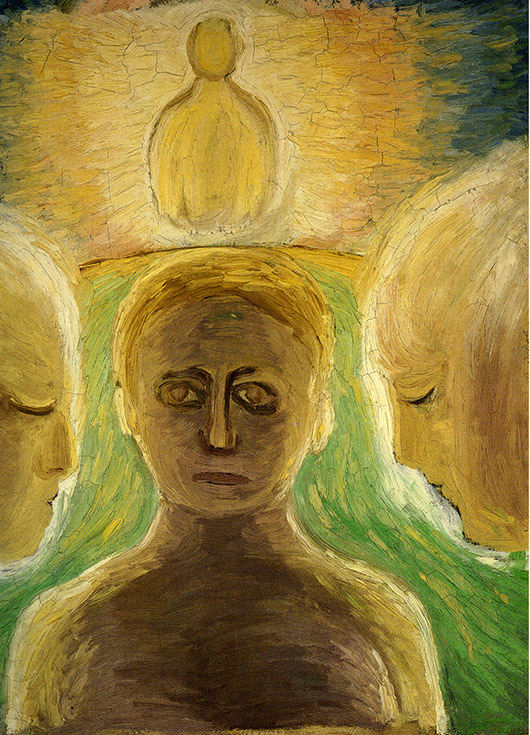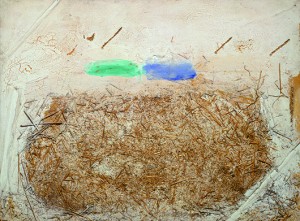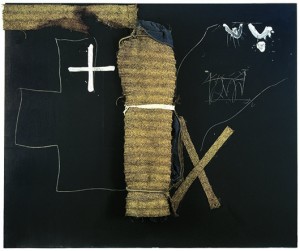MIAMI – On Feb. 6, Pérez Art Museum Miami will open a major historical survey of Catalan master Antoni Tàpies. The first major survey since the artist’s death in 2012, the exhibition is composed of 50 works, including paintings, assemblages and drawings. “Tàpies: From Within” features work from the mid-1940s up through 2011, with notable examples from every decade of the artist’s 70-year-long career.
All the works were drawn from the artist’s own collection, or that of the Fundació Antoni Tàpies in Barcelona. These pieces, which had personal resonance for Tàpies and remained in the artist’s control throughout his lifetime, offer a unique perspective on his creative process. Many of the works selected have rarely been seen prior to this exhibition, providing an intimate glimpse into Tàpies’ relationship with his practice.
This retrospective was organized jointly by the Museu Nacional d’Art de Catalunya and the Fundació Antoni Tàpies, and curated by former Tate Director Vincente Todolí. PAMM’s chief curator, Tobias Ostrander, worked closely with the Fundació and Todoli to choose the 50 works included in PAMM’s focused presentation of “Tàpies: From Within,” which is the sole U.S. presentation of the show. The artist’s early “matter paintings” from the 1950s, up through his recent works, emphasize the materials from which they are made – oil paint mixed with dirt and stones, covered with gestural markings.
Their emphasis on “poor” materials contrast with the gleaming surfaces of Miami, creating a critical dialogue with the museum and its surrounding context. Ostander also emphasizes Tàpies’ influence on a new generation of contemporary artists also interested in discarded materials and rich surfaces. PAMM will open a commissioned project by Argentinian artist Diego Bianchi on Feb. 19, whose appropriation of worn and found materials highlights the link between Tapies’ work and that of many of today’s contemporary artists.
“Tàpies’ emphasis on matter, earth and humble materials, creates an interesting counterpoint to our increasingly digital world,” said Ostrander. “His works were a response to the atomic age and new relationships understood between humans and matter. Today we see many artists increasingly interested in surface textures, density and weight, in physicality and the unique art object; all as a critique of the nonmateriality of the digital world. In this context Tàpies’ alchemical works become a dynamic reference.”
The survey offers a window into the most important artistic and social developments of the postwar world, as seen through the eyes of one of the most successful abstract painters of his generation. Displayed chronologically, the works reveal the influence of major movements in the art world on Tàpies, from surrealism to abstract expressionism, to conceptual art. The impact of pivotal cultural shifts and world events are also evident, such as the explosion of the atomic bomb, ethnic violence and the AIDS epidemic. At the same time, Tàpies steadfast interest in “poor” materials – such as clay, dirt and detritus – remains evident throughout the retrospective. His characteristically bold techniques are on full display, such as his groundbreaking method of “carving” into his canvases by mixing paint with found materials.
Highlights from “Tàpies: From Within” include:
- Fils sobre cartó (Threads on Cardboard), 1946 – a delicate collage represents an early exploration of two materials that would later become established aspects of his practice.
- Gris amb dues taques negres. N. oXCII (Gray with Two Black Marks, No. XCII), 1959 – textured, mixed-media on canvas interpretation of the rebellious New York School style, which was transforming the art world at the time.
- Tela encolada (Glued Fabric), 1961, – a bold reinvention of a sailcloth accented with paint and folded into a compelling geometric design atop a canvas.
- Cadira i roba (Chair and Clothes), 1970 – an elegant yet simple object assemblage that anticipates the arte povera movement.
- Díptic amb dues formes corbes (Diptych with Two Curved Forms), 1988 – a dream-like mixed media reponse to the figurative resurgence of the 1980s.
- Atman, 1996 – displays the strong influence of Asian art on his practice, particularly Japanese calligraphy and the structure of folding screens.
- Sóc terra (I Am Earth), 2004 – a mixture of graffiti-like marks with spray-painted sections, this piece speaks to both the artist’s ecological and spiritual concerns.




